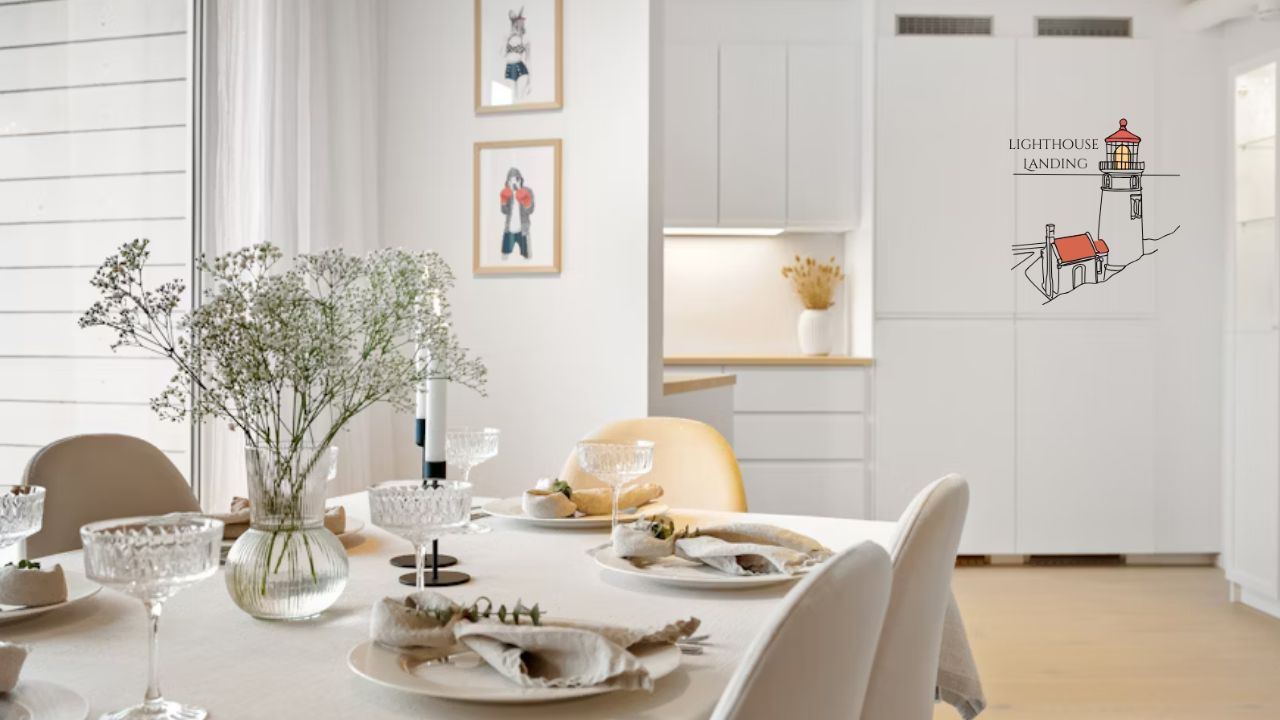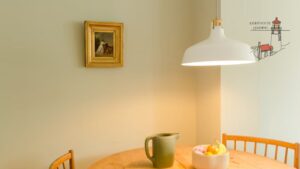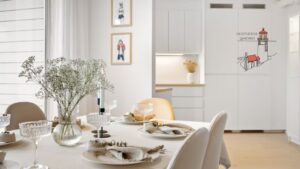Finding the perfect dining room storage solutions can transform your eating space from cluttered chaos into an organized oasis. Whether you’re dealing with limited square footage or simply want to maximize your dining area’s potential, the right storage strategies will revolutionize how you use this important room.
Your dining room serves multiple purposes beyond just meals. It’s where families gather, friends celebrate, and memories are made. But without proper organization, this special space can quickly become overwhelmed with dishes, linens, seasonal decorations, and everyday essentials.
Quick Reference: Dining Room Storage Solutions
| Storage Type | Best For | Price Range | User Rating | Space Required |
|---|---|---|---|---|
| Built-in Buffet | Fine china, linens | $800-$3,000 | 4.7/5 | Large wall space |
| Floating Shelves | Display items, books | $30-$150 | 4.5/5 | Any wall |
| Storage Bench | Placemats, games | $100-$400 | 4.3/5 | Minimal footprint |
| China Cabinet | Formal dinnerware | $500-$2,500 | 4.6/5 | Corner or wall |
| Sideboard | Serving pieces, wine | $300-$1,500 | 4.4/5 | Medium wall space |
| Rolling Cart | Flexible storage | $75-$300 | 4.2/5 | Mobile solution |
Understanding Your Dining Room Storage Needs
Before diving into specific solutions, you need to assess what items require storage in your dining space. Most homeowners struggle with organizing dishes, glassware, table linens, serving pieces, and seasonal decorations.
The average American family owns between 45-60 pieces of dinnerware, according to recent home organization surveys. Add wine collections, specialty serving pieces, and holiday items, and storage needs multiply quickly.
Common Storage Challenges
Many dining rooms suffer from similar organizational problems. Limited built-in storage tops the list of homeowner complaints. Open floor plans, while popular, often leave dining areas without dedicated storage walls.
Small dining spaces present unique challenges. Apartment dwellers frequently struggle to balance storage needs with maintaining an open, welcoming atmosphere. The key lies in choosing dual-purpose furniture and vertical solutions.
Built-In Dining Room Storage Solutions
Built-in storage offers the most seamless integration with your dining room’s design. Custom solutions can maximize every inch while maintaining your space’s aesthetic appeal.
Custom Buffets and Sideboards
A well-designed buffet serves as both storage and serving surface. Interior designer Sarah Richardson notes that built-in buffets “create a focal point while solving multiple storage challenges simultaneously.”
Modern buffets incorporate wine storage, dish drawers, and display areas. Soft-close drawers and adjustable shelving accommodate items of varying sizes. LED lighting inside glass-front cabinets showcases your finest pieces while keeping them dust-free.
User Review Highlight: “Our custom buffet transformed our dining experience. Everything has its place, and entertaining became effortless.” – Jennifer K., verified buyer (5/5 stars)
Wall-Mounted Cabinets
Upper cabinets expand storage without consuming floor space. Glass-front options display collections while protecting items from dust. Solid doors hide everyday essentials, maintaining clean visual lines.
Consider cabinet height carefully. Standard 36-inch placement allows comfortable access while leaving room for dining room light fixtures and artwork above.
Freestanding Dining Room Storage Furniture
Flexible furniture solutions offer storage without major renovations. These pieces can relocate as needs change or accommodate renters seeking temporary solutions.
Traditional China Cabinets
China cabinets remain popular for formal dining room storage, with sales increasing 15% over the past three years. Modern versions incorporate contemporary materials while maintaining classic functionality.
Look for adjustable shelving, interior lighting, and protective felt-lined drawers. Glass shelves create an airy feel while showcasing collections effectively.
Versatile Storage Benches
Storage benches provide seating and hidden storage in compact packages. They’re particularly valuable in smaller dining areas where every square foot counts.
Upholstered versions add comfort and style. Wooden benches offer durability and timeless appeal. Internal dividers help organize different item types efficiently.
Expert Tip: Interior designer Nate Berkus recommends storage benches for families with children: “They provide quick cleanup solutions while offering extra seating for large gatherings.”
Creative Vertical Storage Ideas
Walls represent untapped storage potential in most dining rooms. Vertical solutions draw the eye upward, creating an illusion of greater space while maximizing functionality.
Floating Shelf Systems
Floating shelves offer customizable dining room storage without overwhelming smaller spaces. Arrange them asymmetrically for visual interest or in clean lines for modern appeal.
Restaurant-style plate racks mounted on walls provide easy access while creating professional aesthetics. Commercial-grade options support heavier loads and frequent use.
Wall-Mounted Wine Storage
Wine storage has become increasingly important as home entertaining grows in popularity. Wall-mounted racks save floor space while creating attractive displays.
Consider temperature-controlled options for serious collectors. Standard racks work well for everyday wines consumed within reasonable timeframes.
Smart Storage for Small Dining Rooms
Limited space requires creative thinking. Multi-functional pieces and strategic placement maximize storage without overwhelming compact areas.
Bar Carts and Rolling Storage
Mobile storage adapts to changing needs. Bar carts serve drinks during parties and store linens between events. Their wheels allow easy repositioning for optimal traffic flow.
Modern versions include wine storage, stemware racks, and lower shelving for serving pieces. Mirrored surfaces reflect dining room light, brightening smaller spaces.
Corner Storage Solutions
Corners often go unused in dining rooms. Corner cabinets, triangular shelving units, and rotating storage systems make these areas productive.
Lazy Susan mechanisms provide easy access to items stored in deep corner spaces. This functionality prevents items from becoming forgotten and unused.
Organizing Dining Essentials Effectively
Proper organization systems prevent storage areas from becoming cluttered repositories. Strategic categorization and smart placement improve functionality significantly.
Dish and Glassware Organization
Separate everyday items from special occasion pieces. Everyday dishes should occupy easily accessible locations, while fine china can be stored higher or in less convenient spots.
Plate dividers prevent chipping and make retrieval easier. Stemware racks protect wine glasses and champagne flutes from damage during storage.
Storage Tip: Professional organizer Marie Kondo suggests grouping items by frequency of use rather than just item type.
Linen and Textile Storage
Table linens require protection from wrinkles and stains. Cedar-lined drawers deter moths while maintaining fabric freshness. Acid-free tissue paper prevents permanent creasing in delicate items.
Napkin rings, placemats, and table runners need easy access for regular use. Shallow drawers or pull-out bins work better than deep storage areas.
Seasonal Dining Room Storage Strategies
Holiday entertaining requires temporary storage solutions for special items. Plan ahead to accommodate seasonal dishes, decorations, and serving pieces.
Holiday Dish Storage
Special occasion dinnerware appears infrequently but demands careful protection. Padded storage containers with individual compartments prevent damage during long storage periods.
Clearly labeled bins speed setup and cleanup processes. Store matching sets together to avoid frustrating searches during busy entertaining periods.
Decoration and Centerpiece Storage
Seasonal decorations require organized systems to remain useful year after year. Clear storage containers allow easy identification without opening multiple boxes.
Fragile items need extra protection. Bubble wrap, foam padding, and divided storage compartments prevent breakage during storage periods.
Lighting Considerations for Dining Room Storage
Proper lighting makes storage areas functional and visually appealing. Dining room light placement affects how storage solutions integrate with overall design.
Under-Cabinet Lighting
LED strips under wall cabinets illuminate work surfaces while reducing shadows. This lighting enhances functionality during food preparation and serving activities.
Motion-activated options provide convenience while conserving energy. Battery-powered versions offer flexibility in placement without rewiring requirements.
Interior Cabinet Lighting
Illuminated cabinets showcase collections while making items easier to locate. Automatic lighting systems activate when doors open, providing perfect illumination timing.
LED technology produces minimal heat, protecting stored items from temperature damage. Color temperature affects how items appear, with warm lighting flattering most dinnerware.
Budget-Friendly Storage Solutions
Effective dining room storage doesn’t require massive investments. Smart shopping and DIY projects create functional solutions at reasonable costs.
DIY Storage Projects
Simple floating shelves cost under $50 to build and install. Basic woodworking skills and standard tools are sufficient for most homeowners.
Repurposed furniture offers unique storage character. Vintage dressers, restored buffets, and refinished cabinets provide storage at fraction of new furniture costs.
Affordable Ready-Made Options
Mass-market retailers offer attractive storage solutions starting under $100. While not custom-fitted, these pieces provide immediate functionality improvements.
Shop end-of-season sales for significant savings. Storage furniture often goes on sale during late summer and early fall periods.
Budget Tip: Interior design blogger Emily Henderson suggests mixing high and low-end pieces for balanced aesthetics without overspending.
Maximizing Storage in Open Floor Plans
Open-concept homes present unique dining room storage challenges. Solutions must complement adjacent living spaces while maintaining functional independence.
Room Divider Storage
Storage units that double as room dividers create defined spaces while providing functionality. Bookshelf-style dividers offer display and storage simultaneously.
Consider height carefully in open plans. Lower storage maintains sight lines while providing necessary functionality.
Coordinated Storage Systems
Storage pieces should complement adjacent areas’ furnishings. Consistent materials, colors, and styles create cohesive visual flow throughout open spaces.
Built-in solutions often work best in open floor plans, creating custom storage that appears intentional rather than afterthought additions.
Expert Designer Tips and Tricks
Professional designers share insights that elevate dining room storage from purely functional to beautifully integrated solutions.
Designer Profile: Candice Olson’s Approach
Renowned interior designer Candice Olson, with an estimated net worth of $10 million, built her reputation on functional luxury designs. Her dining room projects consistently feature hidden storage that maintains elegant aesthetics.
Olson advocates for “invisible storage” that serves functions without announcing its presence. Her signature approach involves custom millwork that seamlessly integrates with architectural elements.
Her recent project featured a $15,000 custom buffet with hidden compartments for electronics, wine storage, and display areas. The investment increased the home’s value by $25,000, demonstrating smart dining room storage’s financial benefits.
Professional Organization Strategies
Professional organizers recommend the “zone” approach for dining room storage. Related items stay together, streamlining setup and cleanup processes.
Create zones for:
- Daily dining essentials
- Entertaining pieces
- Seasonal items
- Display collections
This system reduces search time and maintains organization long-term.
Maintenance and Care for Storage Areas
Well-maintained storage systems function better and last longer. Regular cleaning and organization prevent clutter accumulation and damage.
Regular Cleaning Routines
Monthly deep cleaning prevents dust buildup and pest problems. Remove all items, clean surfaces thoroughly, and reorganize contents.
Check for signs of moisture damage, especially in lower cabinets. Address issues immediately to prevent costly replacements.
Long-Term Organization Maintenance
Successful dining room storage requires ongoing attention. Schedule quarterly reviews to assess what’s working and what needs adjustment.
Remove items you no longer use. Donate or sell pieces that don’t serve current needs, freeing space for items you actually use.
Technology Integration in Modern Storage
Smart home technology extends into dining room storage with innovative solutions that enhance functionality and convenience.
Automated Systems
Motion-sensor lighting activates when storage areas open. This technology provides perfect illumination while conserving energy.
Smart inventory systems help track stored items. Apps can catalog collections and remind you of items you own but rarely see.
Climate Control Features
Wine storage benefits from temperature and humidity monitoring. Smart sensors alert you to conditions that might damage collections.
Some high-end dining room storage includes built-in dehumidifiers to protect fine china and silver from moisture damage.
Safety Considerations
Storage solutions must prioritize safety, especially in homes with children or elderly residents.
Secure Mounting
Wall-mounted storage requires proper anchoring to wall studs. Inadequate mounting can result in dangerous failures, especially with heavy items like china collections.
Professional installation ensures safety and prevents costly damage to both storage pieces and stored items.
Child-Safe Storage
Homes with small children need safety latches on lower cabinets. Breakable items should be stored out of reach.
Corner guards and soft-close mechanisms prevent injuries from sharp edges and pinched fingers.
Future Trends in Dining Room Storage
Storage design continues evolving with changing lifestyles and technological advances.
Sustainable Materials
Eco-friendly storage solutions gain popularity as environmental consciousness grows. Bamboo, reclaimed wood, and recycled materials offer attractive, responsible options.
These materials often provide unique character while supporting environmental goals.
Multi-Functional Integration
Future dining room storage will likely incorporate more technology integration. Charging stations for devices, built-in speakers, and smart home controls may become standard features.
Space efficiency demands will drive more multi-functional solutions that serve storage, display, and utility needs simultaneously.
Frequently Asked Questions
Q: How much should I budget for dining room storage solutions?
A: Budget dining room storage starts around $200-500 for basic solutions like floating shelves and storage benches. Mid-range options including quality sideboards and china cabinets range from $500-1,500. High-end custom built-ins can cost $2,000-10,000 depending on size and features.
Q: What’s the most space-efficient dining room storage solution?
A: Vertical wall-mounted storage offers maximum efficiency in minimal space. Floating shelves, wall cabinets, and plate racks utilize unused wall space without consuming floor area. For extremely small rooms, multi-functional furniture like storage benches and bar carts provide flexibility.
Q: How do I prevent my dining room storage from looking cluttered?
A: Choose closed storage for everyday items and reserve open display areas for your most attractive pieces. Maintain consistent spacing between displayed items and use interior lighting to create depth. Limit color variety in displayed pieces to maintain visual cohesion.
Q: Can dining room storage work in open floor plans?
A: Absolutely! Choose storage pieces that complement adjacent living areas’ aesthetics. Lower profile furniture maintains sight lines while room divider-style storage can help define the dining space. Coordinate materials and colors across the open area for visual flow.
Q: How often should I reorganize my dining room storage?
A: Perform quick organization monthly and deep reorganization quarterly. Seasonal transitions provide natural opportunities to assess what’s working and make adjustments. Remove unused items annually to prevent accumulation of unnecessary clutter.
Q: What items should never be stored in dining room cabinets?
A: Avoid storing cleaning chemicals, medications, or items with strong odors near food and dishes. Heat-generating electronics can damage stored items and should be properly ventilated. Valuable items like jewelry should be in secure locations rather than accessible dining storage.
Transform your dining experience with thoughtful storage solutions that blend functionality with style. Whether you choose built-in elegance or flexible furniture pieces, the right dining room storage will enhance both daily meals and special celebrations. Remember that the best storage systems grow with your needs while maintaining the welcoming atmosphere that makes dining rooms the heart of the home.
With proper planning and smart choices, your dining room storage can eliminate clutter, showcase treasured pieces, and create the organized space you’ve always wanted. Start with one area and gradually build your perfect storage system – your future self will thank you every time you entertain or simply enjoy a peaceful family meal.
Admin Recommendation
Your Ultimate Guide to Grand Rivers KY Lighthouse Landing Resort
Discover Paradise at Lighthouse Landing Resort: Your Gateway to Kentucky Lake Adventures












